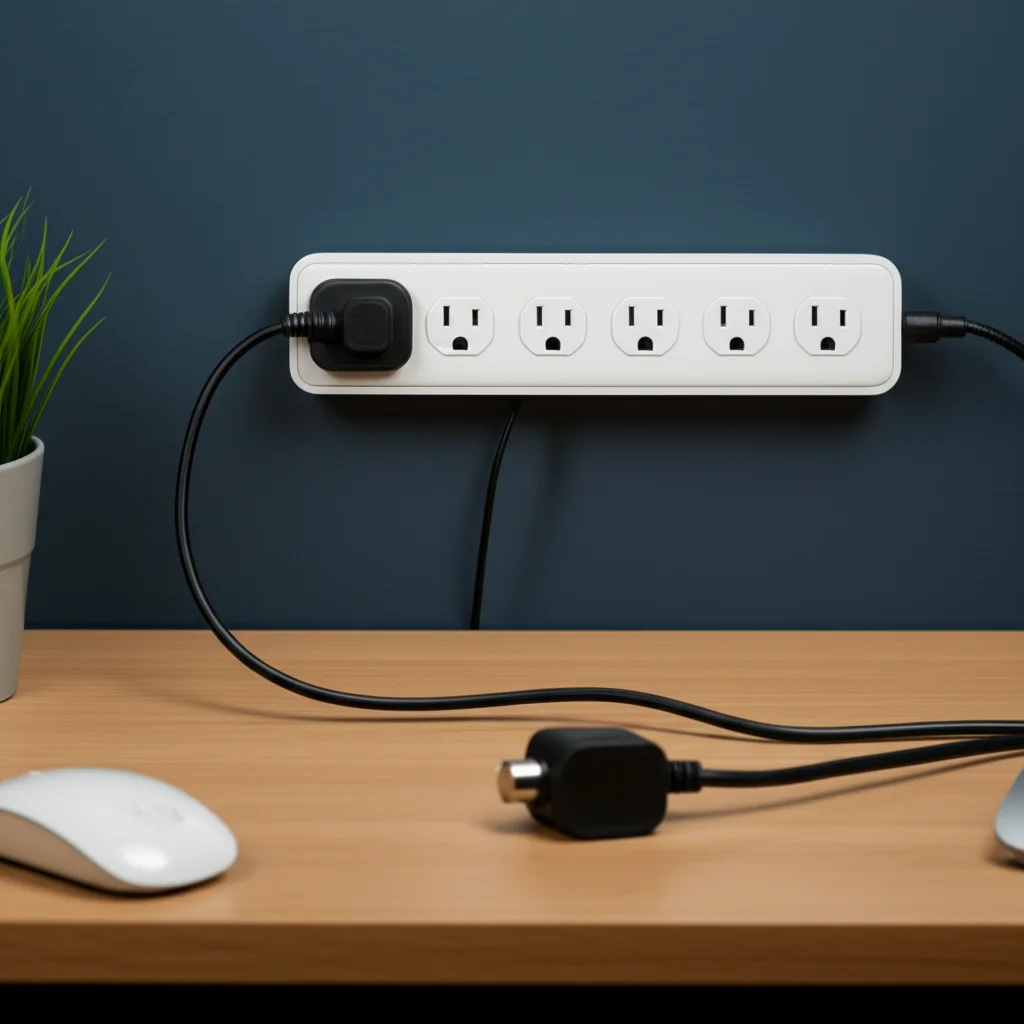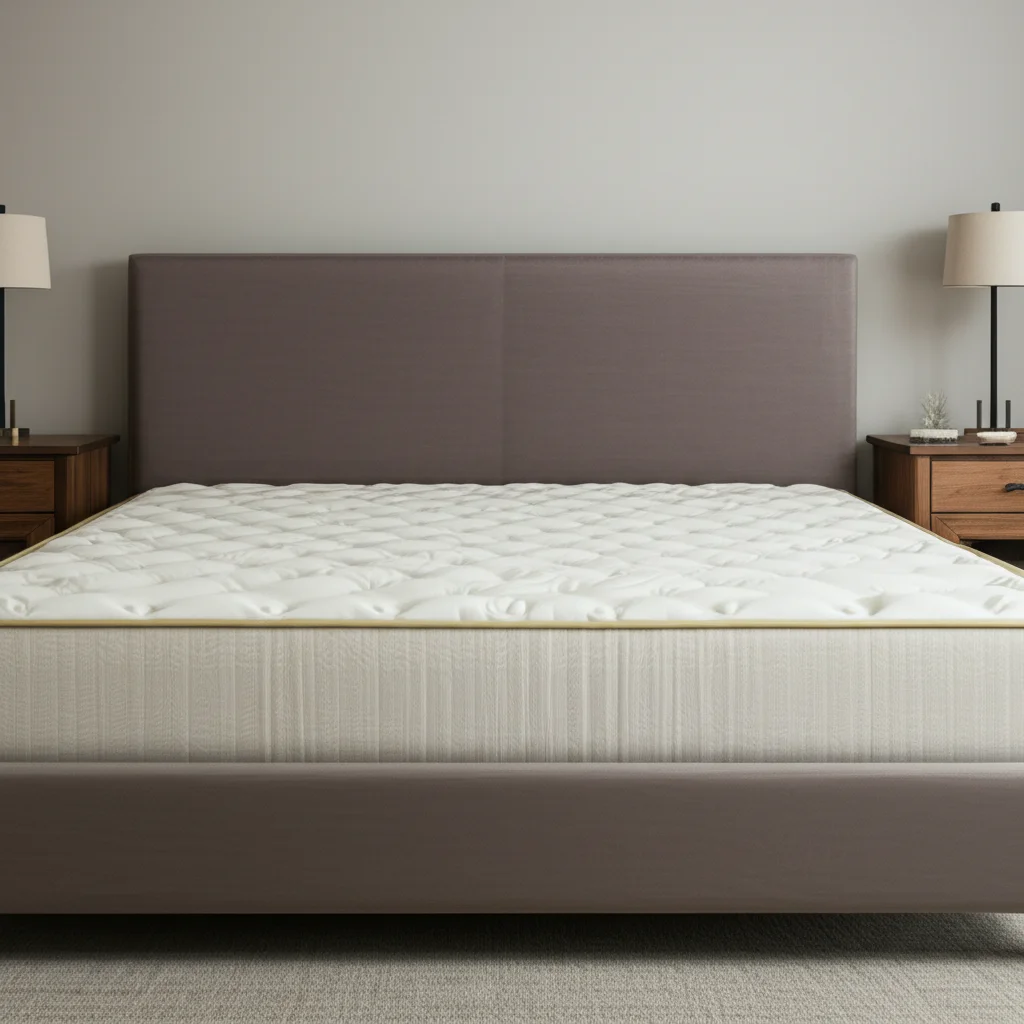· Todd Martin · Home Organization · 19 min read
How To Mount Surge Protector Under Desk

How to Mount a Surge Protector Under Your Desk Easily
Are you tired of tangled cables cluttering your workspace? Does your power strip sit exposed on the floor, collecting dust and posing a tripping hazard? Many people face this issue. A messy setup can reduce productivity and even cause safety risks. You can transform your desk area. Mounting your surge protector under the desk provides an elegant solution. It improves organization and safety.
This guide will show you how to mount a surge protector under your desk. We will explore various methods. You will learn about the tools you need. We cover everything from planning to execution. My aim is to help you create a clean, functional workspace. Get ready to banish desk clutter forever! You can enjoy a tidy and efficient environment.
Takeaway
Mounting your surge protector under the desk offers clear benefits. It declutters your workspace. It enhances safety. It improves the look of your desk area. Choosing the right method and tools makes the process simple. Effective cable management completes the transformation.
Clear Answer
You can mount a surge protector under your desk using screws, strong adhesive strips, or specialized clamps. This process hides cords, prevents tripping hazards, and frees up valuable desk space, creating a neater and safer work environment.
Why Mount Your Surge Protector Under Your Desk?
Mounting your surge protector under your desk changes your workspace. It moves a bulky item from view. This simple act offers many benefits. It is more than just aesthetics.
First, it creates a clean look. Loose cables and power strips are often an eyesore. They sit on the floor or on top of the desk. When you mount the surge protector, these items disappear. Your desk surface becomes clear. The floor space around your desk also clears up. This makes your entire work area appear tidier. A clean space can boost your focus and reduce stress. It helps you keep a professional environment.
Second, it greatly improves safety. An unmounted power strip can be a tripping hazard. Cords can get caught under chair wheels. This can pull devices off the desk. Exposed electrical components also pose risks. Mounting the surge protector reduces these dangers. It secures the unit and its cables. This protects people from accidental trips. It also protects your electronics from damage. Safety is always a top priority in any home or office setup.
Third, it frees up valuable space. Desk space is often limited. Every inch matters. A surge protector sitting on the desk takes up room. Mounting it below the surface gives you that space back. This allows for more room for monitors, keyboards, or other desk items. You can also use the freed-up floor space. This is great for small offices or compact workstations. You can now properly manage multiple cables from different devices. This helps maximize overall desk space with multiple monitors or other peripherals.
Lastly, it makes cleaning easier. Dust and dirt collect around cables and power strips on the floor. It is hard to clean these areas. When your surge protector is mounted, these areas become accessible. You can easily vacuum or wipe the floor. You can also clean the desk surface more thoroughly. This keeps your workspace healthier and more pleasant. These benefits make mounting a surge protector a worthwhile project for anyone.
Choosing the Right Surge Protector for Under-Desk Mounting
Selecting the correct surge protector is an important first step. Not all surge protectors are ideal for mounting. You need to consider several features. The right choice ensures safety and convenience.
First, consider the type and number of outlets. Surge protectors come in various forms. Some are long strips. Others are compact blocks. Think about how many devices you need to power. Consider the size of their plugs. Some plugs are large and can block adjacent outlets. Look for models with widely spaced outlets. Many surge protectors now include USB charging ports. These are very convenient for phones and tablets. They reduce the need for extra wall adapters.
Second, check the joules rating. The joules rating indicates how much energy the surge protector can absorb. Higher joules ratings offer better protection. For valuable electronics like computers or gaming consoles, choose a higher rating. A rating of 1000 joules or more is a good starting point for office setups. This feature is critical for electrical safety and protecting your gear from power surges.
Third, evaluate the cord length. The cord needs to reach your wall outlet comfortably. Measure the distance from your desired mounting spot to the nearest wall outlet. Choose a surge protector with a cord long enough to avoid stretching. Stretching cords can create tension and fire hazards. An appropriate cord length also helps with neat cable routing. It prevents dangling wires.
Fourth, look for mounting features. Many surge protectors have keyhole slots on the back. These slots are designed for screws. Some models come with pre-attached mounting brackets or clamps. These features simplify the installation process. If your chosen surge protector lacks built-in mounting options, do not worry. You can still mount it using other methods. We will discuss these options later in this guide.
Finally, prioritize safety certifications. Always choose a surge protector that is UL listed. UL is short for Underwriters Laboratories. This certification means the product meets specific safety standards. It ensures the device protects your electronics and prevents fire risks. Buying a certified product gives you peace of mind. It confirms the surge protector is reliable and safe for use. Making an informed choice now saves you trouble later.
Essential Tools and Materials for Mounting
Gathering your tools and materials before starting saves time. It ensures a smooth installation process. Most items are common household tools. Some might require a quick trip to a hardware store.
You will need a drill. A cordless drill offers the most flexibility. It makes drilling pilot holes easy. If you do not have a drill, a hand-powered screwdriver might work for softer wood. You also need a screwdriver. Match the screwdriver bit to your screws. Phillips head or flathead are common.
A measuring tape or ruler is essential. It helps you find the perfect mounting spot. You can ensure the surge protector is level and out of the way. A pencil is useful for marking drill points. It helps you visualize the placement before drilling. You can use a level to confirm straight placement. This ensures your surge protector looks good when mounted.
For securing the surge protector, you have options. Small wood screws are necessary if you choose the screw-in method. Make sure they are long enough to hold securely but not so long they pierce through the desk. For adhesive mounting, you will need strong double-sided adhesive strips. Velcro strips with adhesive backing are also an excellent choice. They allow for easy removal and reattachment. You can also buy specialized mounting brackets or clamps. These often come with new surge protectors. If not, they are available at hardware stores.
Cable management accessories are also very helpful. Zip ties are perfect for bundling cables. Cable clips or adhesive cable ties can route wires along the desk legs. Cable sleeves or wraps neatly bundle multiple cables into one tidy tube. These tools are crucial for achieving a truly clutter-free workspace. They hide the wires that run from the surge protector to your devices. This helps you achieve a clean desk appearance.
Lastly, safety gear is important. Wear safety glasses to protect your eyes, especially when drilling. Gloves can protect your hands. Ensure good lighting in your workspace. This helps you see clearly and avoid mistakes. Having everything ready before you start makes the mounting process efficient and safe.
Mounting Methods: Screws, Adhesive, and Clamps
There are several ways to mount a surge protector under your desk. Each method has its own benefits and drawbacks. Your choice depends on your desk material, your preference, and how permanent you want the installation to be.
Screw-In Method
The screw-in method provides a very strong and permanent hold. This approach is best for wooden desks or desks with a solid underside. Many surge protectors come with keyhole slots on the back specifically for this purpose.
To use this method, you first decide where to place the surge protector. Use a pencil to mark the spots for your screws. Make sure the marks align with the keyhole slots. Next, drill small pilot holes at these marked points. Pilot holes prevent the wood from splitting. They make screwing easier. Then, insert screws into the pilot holes. Leave a small gap between the screw head and the desk surface. This gap allows the surge protector to slide onto the screw heads. Finally, align the keyhole slots with the screw heads and push the surge protector into place. Slide it down until it locks firmly. This method offers great stability. It ensures your surge protector stays put.
Adhesive Strip Method
The adhesive strip method is popular for its ease and lack of damage. This is perfect if you want to avoid drilling into your desk. It works well on various surfaces like wood, metal, and even glass. It is a great option if you need to mount a power strip to your desk without screws.
Before applying adhesive strips, clean the mounting surface thoroughly. Use rubbing alcohol to remove any dust or grease. This ensures a strong bond. Allow the surface to dry completely. Apply strong double-sided adhesive strips to the back of the surge protector. Ensure the strips cover enough surface area for a secure hold. Peel off the backing from the strips. Carefully position the surge protector under your desk. Press it firmly against the surface for at least 30 seconds. Apply consistent pressure. For best results, let the adhesive cure for a few hours before plugging in devices. This method is quick and leaves no holes. It is also good for temporary setups.
Clamp-On or Bracket Systems
Clamp-on or specialized bracket systems offer a non-invasive mounting solution. These are excellent for desks you do not want to drill into. They are also ideal for standing desks or desks with metal frames.
Some surge protectors come with built-in clamp systems. You simply attach the clamps to the edge of your desk. Tighten them to secure the unit. Other systems involve separate brackets. You attach these brackets to the desk with clamps or screws. Then, the surge protector slides into the brackets. These systems often allow for easy removal or repositioning. They are very versatile. This method offers adjustability. It is good for people who move their desk setups often. It provides a stable mount without permanent modifications. You can find these systems online or at office supply stores.
Each method provides a way to mount your surge protector under your desk. Consider your desk type and how permanent you want the installation. Choose the method that fits your needs best.
Step-by-Step Guide to Mounting Your Surge Protector
Mounting your surge protector is a simple process. Following these steps ensures a successful and secure installation. Let’s walk through it together.
1. Plan Your Placement and Cable Route
Before you do anything, decide where your surge protector will go. Look under your desk. Consider where your devices are located. You want the surge protector to be easily accessible but out of sight. Think about the length of your device cables. Plan a route for all the cords. They should run neatly from your devices to the surge protector. They should then run from the surge protector to the wall outlet. Avoid areas where your legs might hit the unit. Also, keep it away from moving parts of your chair. A good plan prevents cable tangles later. It creates a neat workspace setup.
2. Gather Your Tools and Prepare Your Workspace
Collect all the tools and materials you decided on. This includes your surge protector, chosen mounting hardware (screws, adhesive strips, or clamps), a drill, screwdriver, measuring tape, pencil, and any cable management accessories. Clear the area under your desk. Move your desk chair out of the way. Unplug all devices from your existing power strip or wall outlets. This step is crucial for safety. It prevents electrical shocks during installation. Make sure you have good lighting.
3. Mount the Surge Protector
Now, it’s time to attach the surge protector.
For Screw-In Method:
- Hold the surge protector in your chosen spot.
- Use a pencil to mark the locations for the screws through the keyhole slots.
- Remove the surge protector.
- Drill pilot holes at your marked spots. Use a drill bit slightly smaller than your screws.
- Insert the screws into the pilot holes, leaving about 1/8 inch of the screw head exposed.
- Align the keyhole slots on the surge protector with the screw heads.
- Slide the surge protector onto the screws. Gently push it down until it feels secure.
For Adhesive Strip Method:
- Clean the mounting surface under your desk thoroughly with rubbing alcohol. Let it dry completely.
- Apply strong double-sided adhesive strips or Velcro strips to the back of the surge protector. Ensure good coverage.
- Peel off the backing from the adhesive.
- Carefully position the surge protector in your desired spot.
- Press firmly for at least 30 seconds. Apply pressure evenly across the entire unit.
- Allow the adhesive to cure for a few hours before plugging in devices. This ensures a strong bond.
For Clamp-On/Bracket Systems:
- Follow the specific instructions provided with your clamp or bracket system.
- Typically, you will attach the clamps to the desk edge or screw brackets into the desk.
- Then, slide the surge protector into the installed clamps or brackets.
- Ensure the system is tightened securely.
4. Plug In Devices and Manage Cables
Once the surge protector is firmly mounted, plug in your devices. Start with the main power cable of the surge protector. Plug it into the wall outlet. Then, plug your computer, monitors, and other peripherals into the surge protector.
This is the perfect time for cable management. Use zip ties, cable clips, or cable sleeves to bundle loose cords. Route them neatly along the underside of your desk or down a desk leg. Avoid letting cables dangle. Use adhesive cable clips to secure cables to the desk frame. This keeps them out of sight and prevents tangles. Ensure enough slack in cables so they do not pull tightly. This prevents damage. A well-managed cable system makes your workspace look professional. It also reduces future headaches.
Cable Management Tips for a Clutter-Free Desk
Mounting your surge protector is a big step. However, effective cable management completes the transformation. It ensures your desk stays clean and functional. Here are some simple tips to achieve a truly clutter-free environment.
First, use cable ties or zip ties. These are inexpensive and highly effective. Group similar cables together. For example, bundle all monitor cables. Group all charging cables. This prevents them from becoming a tangled mess. Wrap the ties snugly but not too tightly. You should still be able to move the cables if needed. Zip ties also help keep extra cable length coiled and out of the way.
Second, consider cable sleeves or wraps. These are fabric or plastic tubes. They enclose multiple cables. This creates a single, clean bundle. Cable sleeves are great for areas with many wires. Think behind your computer tower or along a monitor arm. They come in various sizes and colors. You can choose one that blends with your desk setup. Sleeves make your cable runs look professional. They also protect cables from dust and damage.
Third, utilize adhesive cable clips. These small clips stick to your desk or desk legs. They guide individual cables along a desired path. You can use them to route cables discreetly. For example, run a mouse cable along the underside edge of your desk. This keeps it from flopping around on the desktop. They are especially useful for managing power cords and USB cables. Make sure to clean the surface before applying the clips for a strong hold.
Fourth, invest in a cable management tray or channel. These trays attach under your desk. They provide a space to lay power bricks and excess cable length. They keep everything completely hidden. Some trays are open baskets. Others are enclosed channels. They are excellent for managing large amounts of cables. They keep your desk organization clean. These trays are very useful for a fully customized workstation.
Fifth, label your cables. This seems like a small detail. It saves a lot of frustration later. Use small labels or colored tape. Mark which cable belongs to which device. This is especially helpful when you need to unplug something. It prevents you from unplugging the wrong device. Labels make troubleshooting much easier. They simplify future adjustments to your setup.
Finally, regularly review your cable setup. As you add or remove devices, your cable needs change. Take a few minutes every few months. Re-bundle cables. Re-route them as needed. This proactive approach keeps your workspace consistently tidy. Good cable management is an ongoing process.
Safety Considerations and Best Practices
Mounting your surge protector enhances your workspace. It also brings important safety responsibilities. Electrical safety is paramount. Following best practices ensures your setup is not only neat but also secure.
First, never overload your surge protector. Each surge protector has a maximum power rating. This is usually listed in watts or amps. Do not plug in too many high-power devices. Examples include heaters, vacuums, or microwaves. Overloading can cause the unit to overheat. It can lead to tripped circuit breakers or even fires. Always check the total wattage of your devices before plugging them in. Distribute your devices evenly across available outlets.
Second, ensure proper ventilation. Surge protectors generate a small amount of heat during operation. Mounting them in an enclosed space without airflow can cause overheating. Make sure there is enough clear space around your mounted surge protector. This allows heat to dissipate naturally. Avoid mounting it inside a closed cabinet. Do not cover it with fabric or other materials. Good ventilation extends the life of your surge protector. It also prevents fire hazards.
Third, regularly inspect your surge protector. Check for any signs of damage. Look for frayed cords, cracked casings, or discolored outlets. A damaged surge protector is unsafe. It may not provide adequate protection. Replace any damaged unit immediately. Also, check the indicator lights. Many surge protectors have lights that show if they are providing protection. If the protection light is off, the unit has likely absorbed a surge. It might need replacement.
Fourth, consider child and pet safety. A mounted surge protector is less accessible. This helps protect curious children and pets. However, ensure all cables are tucked away. Use cable management tools to prevent dangling wires. Small children or pets might still pull on loose cords. This can cause devices to fall. It can also create an electrical hazard. Secure all power cords firmly.
Fifth, use the correct type of surge protector. As mentioned, ensure it is UL listed. This certification confirms it meets safety standards. Do not use ordinary power strips in place of surge protectors. Power strips only add outlets. They do not protect against voltage spikes. Only a true surge protector offers protection for your electronics.
Finally, avoid daisy-chaining. Never plug one surge protector into another. This practice is known as daisy-chaining. It can easily overload electrical circuits. It also negates the protective features of the surge protector. Plug your surge protector directly into a wall outlet. These safety measures ensure your under-desk setup is both organized and safe for your home.
Frequently Asked Questions
Can I mount any surge protector under my desk?
Not every surge protector is designed for mounting. Many have keyhole slots on the back for screws. Others might need adhesive strips or clamps. Choose a surge protector with built-in mounting options for easier installation. If it lacks these, ensure its shape allows for secure attachment with universal brackets or strong adhesive.
What if my desk is made of glass or metal?
For glass or metal desks, avoid drilling. The screw-in method is not suitable. Instead, use strong double-sided adhesive strips or heavy-duty Velcro. Clamp-on surge protectors or those with specialized mounting brackets are also excellent choices. These options provide a secure hold without damaging the desk surface.
How do I hide the cables after mounting the surge protector?
After mounting, use cable management tools to hide cables. Zip ties or Velcro straps bundle cables together. Adhesive cable clips guide wires along desk legs or undersides. Cable sleeves or wraps enclose multiple cords into one neat tube. Cable management trays attach to the desk bottom and conceal power bricks and excess length.
Is it safe to mount a surge protector with screws?
Yes, mounting a surge protector with screws is a safe and secure method for wooden desks. Ensure you use appropriate screws that do not pierce through the desk surface. Drill pilot holes slightly smaller than the screws to prevent wood splitting. This method provides a very stable and permanent hold for your surge protector.
How often should I replace my surge protector?
Surge protectors have a limited lifespan. They degrade over time, especially after absorbing multiple power surges. Most manufacturers recommend replacing them every 3-5 years. If your surge protector’s “protection” indicator light is off, it means it has sacrificed itself to protect your devices and needs immediate replacement.
Can mounting a surge protector improve Wi-Fi signal?
Mounting a surge protector itself does not directly improve Wi-Fi signal. However, a decluttered workspace with organized cables can reduce electromagnetic interference. Loose, tangled cables can sometimes create interference. A cleaner setup might indirectly contribute to a more stable environment for your Wi-Fi router and devices.
Conclusion
Creating a clean, organized, and safe workspace is simpler than you think. Learning how to mount a surge protector under your desk is a key step in this process. You eliminate unsightly cable clutter. You reclaim valuable desk space. Most importantly, you enhance the safety of your home or office environment. This simple DIY project brings big benefits.
We explored why mounting is essential. We discussed selecting the right surge protector. We went over the necessary tools and materials. You now understand the different mounting methods. Whether you prefer screws, adhesive, or clamps, there is a solution for your desk. We also provided a step-by-step guide. Effective cable management tips help you finish the job. Finally, we emphasized critical safety considerations. These practices ensure your setup is secure and reliable.
Take action today. Say goodbye to messy cables and exposed power strips. Implement these strategies. You will enjoy a more functional, aesthetically pleasing, and safer workspace. Start your journey to a more organized desk. A tidy environment fosters better focus and productivity. Transform your desk now and experience the difference!





